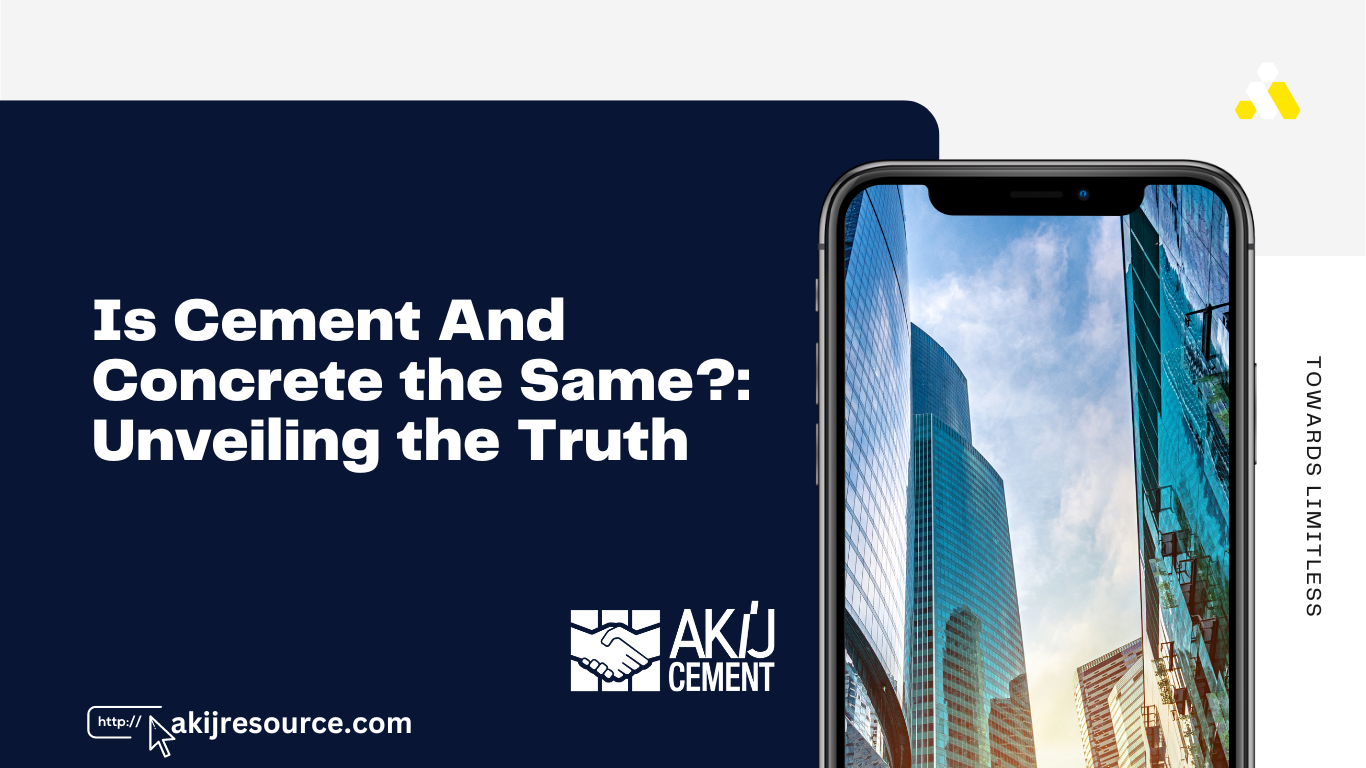Cement and concrete are not the same. Cement is an ingredient in concrete.
Cement is a fine powder made from limestone and other minerals. It acts as a binder when mixed with water. Concrete is a composite material made from cement, sand, gravel, and water. Builders use concrete for its strength and durability.
Concrete is essential in constructing buildings, roads, and bridges. Cement alone cannot offer the same structural support. Understanding the difference helps in choosing the right materials for construction projects. Cement is crucial, but it is just one part of the concrete mix. Using the right proportions ensures a strong and long-lasting structure.

Credit: gharpedia.com
Cement Vs. Concrete: Common Misconceptions
Many people often use the terms cement and concrete interchangeably. This common mistake can lead to confusion. Understanding the differences between the two is crucial for any construction project.
Myths Debunked
One major myth is that cement and concrete are the same. This is not true. Cement is an ingredient in concrete, not the other way around.
Concrete is a mixture of cement, sand, gravel, and water. The cement acts as a binder. It holds everything together.
Popular Beliefs
Many believe that concrete is stronger than cement. This is only partially true. Cement alone is not as strong as concrete. The combination of materials in concrete gives it strength.
Another common belief is that cement can be used for all types of construction. This is incorrect. Cement is mostly used for smaller projects. Concrete is used for larger structures like buildings and bridges.
Table Of Differences
| Aspect | Cement | Concrete |
|---|---|---|
| Definition | Binder material | Mixture of cement, sand, gravel, water |
| Usage | Smaller projects | Larger structures |
| Strength | Less strong | More strong |
- Cement is a key ingredient in concrete.
- Concrete is a mixture that includes cement.
- Concrete is used for large projects. Cement is used for smaller ones.
Understanding these differences can help you make better choices in construction. Now you know that cement and concrete are not the same.
Composition Breakdown
Many people confuse cement and concrete. They are not the same. Both have different compositions. Understanding their ingredients helps in knowing their differences.
Cement Ingredients
Cement is a fine powder. It is made by heating limestone and clay. This mixture is called clinker. The clinker is then ground into a fine powder. Gypsum is added to control the setting time. Cement has four main ingredients:
- Limestone – Provides calcium.
- Clay – Provides silica, alumina, and iron.
- Gypsum – Controls the setting time.
- Clinker – The main component.
Concrete Mix
Concrete is a mixture. It is made up of cement, water, sand, and gravel. These ingredients are mixed together to form a strong material. The composition of concrete includes:
- Cement – The binder.
- Water – Activates the cement.
- Sand – Provides bulk.
- Gravel – Adds strength.
Concrete uses cement as one of its ingredients. This makes it different from cement. While cement is just a part of concrete, concrete is a complete building material.
Historical Context
Many people think cement and concrete are the same. They are not. Understanding their history helps. Let’s dive into how these materials evolved over time.
Ancient Uses
Ancient civilizations used early forms of cement. The Egyptians used a mix of mud and straw to create bricks. They also used gypsum and lime mortars for the pyramids. The Greeks and Romans improved on these methods.
The Romans were masters of early concrete. They mixed lime, water, sand, and volcanic ash. This mix created a strong material. The Romans used it to build the Colosseum and aqueducts. These structures still stand today.
Evolution Over Time
Concrete evolved over centuries. In the 1700s, John Smeaton created modern cement. He used limestone and clay. This mix set underwater. It was perfect for building lighthouses.
In 1824, Joseph Aspdin invented Portland cement. He named it after the stone from Portland, England. This type of cement set quickly and became very popular.
By the 20th century, concrete became a global building material. Reinforced concrete, with steel bars inside, added strength. Skyscrapers and bridges used this new material. It changed the look of cities forever.
Today, concrete is vital for construction. It builds homes, roads, and skyscrapers. Its history shows its importance in human development.
The Role Of Cement In Concrete
Cement and concrete are often confused. Understanding the role of cement in concrete helps clarify their differences. Cement is a key ingredient in concrete. It acts as a binder, holding all components together. Without cement, concrete would not exist.
Binding Properties
Cement’s binding properties are essential. Cement binds sand, gravel, and water together. This mixture forms a solid mass. This mass is known as concrete. Cement’s binding strength provides durability and strength to structures. Without this binding power, buildings would crumble.
Chemical Reactions
Cement undergoes chemical reactions when mixed with water. These reactions are crucial for concrete formation. The primary reaction is called hydration. Hydration causes cement particles to harden and interlock. This process creates the solid structure of concrete.
Here is a simple table showing the key components involved in the chemical reaction:
| Component | Role |
|---|---|
| Cement | Binder |
| Water | Activates cement |
| Sand | Filler |
| Gravel | Filler |
Hydration continues over time. This ongoing process strengthens the concrete further. The chemical reactions are complex but essential. They ensure the concrete remains robust and durable.
To summarize, cement’s binding properties and chemical reactions are vital. They transform a simple mixture into strong, durable concrete.
Properties And Characteristics
Understanding the properties and characteristics of cement and concrete is essential. This helps in selecting the right material for construction projects. Both materials have unique attributes. These affect their performance, usability, and suitability for different applications.
Strength And Durability
Cement itself is not strong. It serves as a binder when mixed with other materials. Concrete, on the other hand, is known for its strength and durability. This makes it a preferred choice for building structures.
Concrete’s strength comes from the chemical reaction between cement and water. This reaction forms a hard matrix that binds other materials together. The durability of concrete makes it resistant to weathering, chemicals, and wear.
Here is a quick comparison of their properties:
| Property | Cement | Concrete |
|---|---|---|
| Strength | Low (as a standalone) | High |
| Durability | Low | High |
Setting Time
The setting time of cement and concrete is crucial in construction. Cement begins to set when mixed with water. The initial setting time is around 30 minutes. The final setting time is about 10 hours.
Concrete, once mixed, starts to set within a few hours. It gains significant strength in the first few days. Full strength can take up to 28 days. This gradual process ensures the stability of structures.
Factors affecting setting time include:
- Temperature
- Humidity
- Mix proportions
Understanding these properties helps in making informed decisions. This ensures the success of construction projects.

Credit: m.youtube.com
Diverse Applications
Cement and concrete are often confused, but they serve different purposes. Both materials have diverse applications in various fields. This section explores their unique uses in construction and specialized projects.
Construction Projects
Concrete is a versatile material in construction. It is used in building foundations, walls, and floors. Here are some common applications:
- Residential Buildings: Concrete is used for driveways, patios, and sidewalks.
- Commercial Structures: Skyscrapers and shopping centers rely on concrete for their structural integrity.
- Infrastructure: Bridges, tunnels, and highways are built using concrete for its durability.
Cement acts as a binder in concrete. It is also used in masonry work. Builders use cement for bricklaying and plastering.
Specialized Uses
Cement and concrete have specialized applications beyond construction. These include:
| Application | Description |
|---|---|
| Waterproofing | Cement is used in waterproof coatings for basements and roofs. |
| Decorative Concrete | Concrete can be stamped or colored for aesthetic purposes. |
| Art and Sculpture | Artists use concrete to create durable sculptures and installations. |
Concrete is also used in marine construction. It builds structures like docks and sea walls due to its resistance to water.
In the field of energy, concrete is used in the construction of wind turbine bases. It provides stability and support for these massive structures.
Environmental Impact
The environmental impact of cement and concrete is a crucial topic. The production of these materials affects our planet. Understanding their differences can help make greener choices.
Sustainability Concerns
Cement production is a major source of carbon emissions. It involves heating limestone, which releases CO2. This process is energy-intensive and pollutes the air.
Concrete, made with cement, aggregates, and water, has a lower impact than pure cement. But, its widespread use still contributes to CO2 emissions. The extraction of raw materials also harms ecosystems.
| Material | CO2 Emissions | Impact on Ecosystems |
|---|---|---|
| Cement | High | Significant |
| Concrete | Moderate | Moderate |
Choosing alternative materials can reduce these impacts. Recycled aggregates and low-carbon cements are better options.
Innovations In Green Building
New technologies aim to lessen the environmental footprint of construction. Some innovations include:
- Carbon Capture and Storage (CCS): This technology captures CO2 emissions from cement plants. It stores the CO2 underground.
- Geopolymer Concrete: Made from industrial waste, it has a smaller carbon footprint. It uses less energy and raw materials.
- Recycled Concrete: Using crushed concrete as aggregate reduces the need for new materials. It also cuts down waste in landfills.
These innovations help create a more sustainable construction industry. They offer practical solutions to reduce environmental harm.
By embracing these green building practices, we can protect our planet. Making informed choices in construction materials is essential.
Future Of Building Materials
The future of building materials is bright. New technologies are transforming the industry. It’s important to understand if cement and concrete are the same. Both materials have different roles in construction. Cement is a key ingredient in concrete. Concrete is a mixture of cement, sand, gravel, and water. Let’s dive into the future trends and advanced materials shaping construction.
Advanced Composites
Advanced composites are changing the construction world. These materials are strong and lightweight. They are made from a mix of different substances. Fiberglass and carbon fiber are popular examples. These composites offer many benefits:
- High strength-to-weight ratio
- Corrosion resistance
- Design flexibility
- Durability
These materials are used in buildings, bridges, and roads. They reduce the weight of structures. They also increase the lifespan of buildings. Construction projects finish faster with advanced composites.
Trends In Construction
The construction industry is evolving. New trends are emerging every year. Here are some key trends:
- Sustainable Building: Using eco-friendly materials to reduce the carbon footprint.
- 3D Printing: Creating building components with precision and speed.
- Modular Construction: Building sections off-site and assembling them on-site.
- Smart Buildings: Integrating technology for energy efficiency and comfort.
Sustainable materials like recycled steel and bamboo are popular. 3D printing allows for rapid prototyping and design customization. Modular construction saves time and resources. Smart buildings use sensors and automation for better energy management.
The future of building materials is exciting. Innovations and trends are reshaping the industry. Understanding these changes is key to building better structures. Remember, cement and concrete are not the same, but both play vital roles in construction.
:max_bytes(150000):strip_icc()/difference-between-cement-concrete-and-mortar-2130884-final-ac-5c1aa0e546e0fb0001909553-fd07f31197cd491e85bf0eb8200f6f5e.png)
Credit: www.thespruce.com
What is the Difference Between Cement and Cement Slurry?
Cement is a bonding agent used in construction, while cement slurry is a mixture of cement, water, and sometimes additives. The main difference is the consistency, with cement being a powder and cement slurry being a viscous liquid. Check online for a make cement slurry tutorial to learn more.
Frequently Asked Questions
What Is The Difference Between Cement And Concrete?
Cement is a binder, while concrete is a mixture of cement, sand, gravel, and water. Cement hardens and binds materials, forming concrete.
Is Pure Cement Stronger Than Concrete?
Concrete is stronger than pure cement. Cement alone is brittle and lacks the strength of concrete’s mix of cement, sand, and gravel.
Should I Buy Concrete Or Cement?
Buy concrete for large projects like driveways or foundations. Choose cement for smaller tasks like patching or setting posts.
Are Sidewalks Concrete Or Cement?
Sidewalks are typically made of concrete, not cement. Cement is an ingredient in concrete. Concrete is durable and suitable for sidewalks.
Conclusion
Understanding the difference between cement and concrete is crucial. Cement is a component, while concrete is the final product. Knowing this helps in making informed decisions for construction projects. Always choose the right material to ensure durability and strength. Keep these distinctions in mind for successful building outcomes.
{ “@context”: “https://schema.org”, “@type”: “FAQPage”, “mainEntity”: [ { “@type”: “Question”, “name”: “What is the difference between cement and concrete?”, “acceptedAnswer”: { “@type”: “Answer”, “text”: “Cement is a binder, while concrete is a mixture of cement, sand, gravel, and water. Cement hardens and binds materials, forming concrete.” } } , { “@type”: “Question”, “name”: “Is pure cement stronger than concrete?”, “acceptedAnswer”: { “@type”: “Answer”, “text”: “Concrete is stronger than pure cement. Cement alone is brittle and lacks the strength of concrete’s mix of cement, sand, and gravel.” } } , { “@type”: “Question”, “name”: “Should I buy concrete or cement?”, “acceptedAnswer”: { “@type”: “Answer”, “text”: “Buy concrete for large projects like driveways or foundations. Choose cement for smaller tasks like patching or setting posts.” } } , { “@type”: “Question”, “name”: “Are sidewalks concrete or cement?”, “acceptedAnswer”: { “@type”: “Answer”, “text”: “Sidewalks are typically made of concrete, not cement. Cement is an ingredient in concrete. Concrete is durable and suitable for sidewalks.” } } ] }







